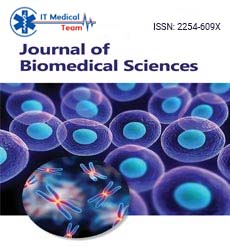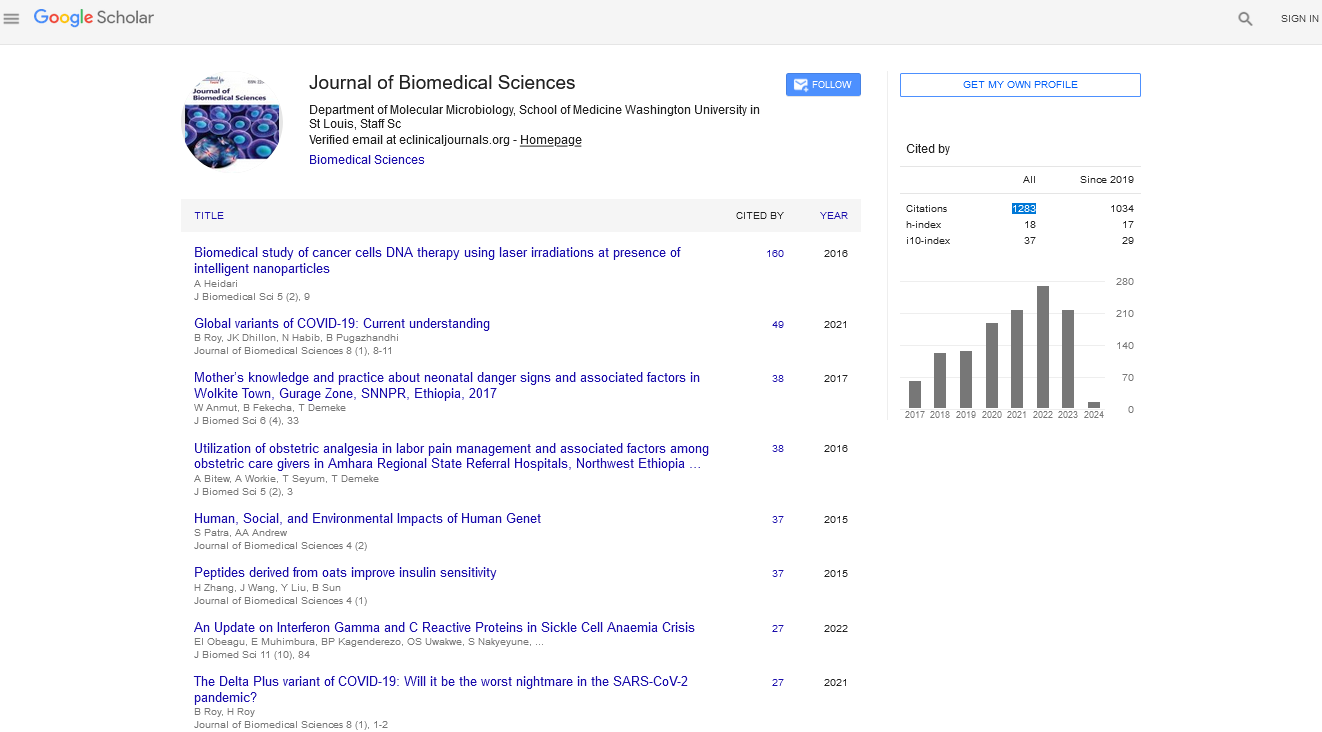Perspective - (2024) Volume 13, Issue 5
Nanotechnology in Drug Delivery Systems
Jorge Mateo*
Department of Pharmacology and Biomedical Sciences, University of Barcelona, Barcelona, Spain
*Correspondence:
Jorge Mateo, Department of Pharmacology and Biomedical Sciences, University of Barcelona, Barcelona,
Spain,
Email:
Received: 20-Sep-2024, Manuscript No. IPJBS-24-15328;
Editor assigned: 23-Sep-2024, Pre QC No. IPJBS-24-15328 (PQ);
Reviewed: 07-Oct-2024, QC No. IPJBS-24-15328;
Revised: 17-Oct-2024, Manuscript No. IPJBS-24-15328 (R);
Published:
24-Oct-2024
Introduction
Nanotechnology has revolutionized medicine, particularly in
drug delivery, where its precise control over size, shape, and
surface characteristics enables new possibilities for targeting,
efficacy, and safety in treating diseases. Nanotechnology allows
for the engineering of particles on the nanometer scale, making
it possible to create specialized carriers that improve the
delivery of therapeutic agents directly to the disease site. This
targeted approach minimizes side effects, reduces dosage
requirements, and enhances treatment outcomes, especially in
complex diseases like cancer, neurological disorders, and
infectious diseases. In this article, we will explore the principles
of nanotechnology in drug delivery, recent advances, the types
of nanocarriers, and future perspectives.
Description
Principles of nanotechnology in drug delivery
Nanotechnology involves designing, synthesizing, and utilizing
materials on a scale typically below 100 nanometers. In drug
delivery, this scale provides several benefits:
Enhanced Permeability and Retention (EPR) effect: Due to
their small size, nanoparticles can exploit the unique physiology
of tumors and inflamed tissues, allowing them to accumulate at
the target site while sparing healthy tissues.
Surface modification for targeting: Nanoparticles can be
modified with specific ligands that recognize and bind to
receptors on diseased cells, enhancing targeting precision.
Controlled release and bioavailability: Nanoparticles can be
engineered to release drugs over a specified period or in
response to specific environmental triggers, ensuring a steady
supply of therapeutic agents.
Stability of sensitive drugs: Encapsulation within nanoparticles
protects unstable drugs from degradation, enhancing their
effectiveness and shelf life.
These characteristics enable nanotechnology to address
several limitations of conventional drug delivery, such as poor
bioavailability, rapid degradation, and off-target effects.
Types of nanocarriers in drug delivery
Several types of nanoparticles serve as drug delivery vehicles,
each with unique properties that make them suitable for specific
therapeutic applications.
Liposomes: Liposomes are vesicles with a lipid bilayer that
mimics cell membranes, making them biocompatible and
versatile. They can encapsulate both hydrophilic and hydrophobic
drugs, offering flexibility in drug formulation. Liposomes are
widely used in cancer therapy and have shown promising results
in delivering drugs for infectious diseases. A well-known example
is Doxil®, a liposomal formulation of doxorubicin used to treat
various cancers.
Polymeric nanoparticles: Made from biocompatible polymers
like PLGA (Poly(Lactic-co-Glycolic Acid)) or PEG (Polyethylene
Glycol), polymeric nanoparticles allow for controlled drug
release. The surface of these nanoparticles can be modified for
targeted delivery, making them valuable for treating cancer,
cardiovascular diseases, and inflammation. Their ability to
degrade over time enables them to release drugs at a consistent
rate, ideal for chronic conditions.
Dendrimers: Dendrimers are highly branched, tree-like
structures with multiple functional groups on their surface,
which makes them ideal for attaching drug molecules, targeting
agents, or imaging molecules. Dendrimers provide controlled
release capabilities and offer high payload capacity. This unique
structure has applications in cancer therapy and diagnostic
imaging, where multifunctional carriers are beneficial.
Carbon Nanotubes (CNTs): CNTs are cylindrical molecules
with a large surface area and excellent chemical stability, making
them suitable for drug loading. Due to their hydrophobic nature,
they are primarily used for carrying hydrophobic drugs and are
often modified with functional groups to enhance water
solubility. While promising, the safety profile of CNTs is still
under study.
Metallic nanoparticles (gold and silver): Metallic nanoparticles
like gold and silver have unique optical and thermal properties,
making them suitable for diagnostic imaging and drug delivery.
Gold nanoparticles, in particular, can be designed to absorb
specific wavelengths, allowing for photothermal therapy, where
localized heat generated by the particles kills cancer cells.
Micelles: Micelles are spherical structures formed by
amphiphilic molecules that can encapsulate hydrophobic drugs
within their core, increasing their solubility in aqueous
environments. They are particularly useful in delivering poorly
soluble drugs, improving bioavailability, and minimizing side
effects. Paclitaxel, a cancer drug with low solubility, is delivered
using micelle-based carriers.
Applications of nanotechnology in drug delivery
Nanotechnology has paved the way for innovative approaches
in treating several diseases by addressing the limitations of
traditional drug delivery methods. Here are some key
applications:
Cancer therapy: Traditional chemotherapy affects both
cancerous and healthy cells, leading to numerous side effects.
Nanoparticles enable targeted delivery to tumor cells while
sparing healthy tissues. For instance, nanocarriers like liposomes
and polymeric nanoparticles loaded with chemotherapeutics
deliver drugs directly to tumors by taking advantage of the EPR
effect. Nanoparticles can also carry multiple drugs, allowing for
combination therapy, which is often more effective than singledrug
regimens.
Neurological disorders: The Blood-Brain Barrier (BBB)
presents a major challenge for delivering drugs to the brain.
Nanotechnology offers solutions by creating nanoparticles
capable of crossing the BBB. These nanocarriers can deliver
drugs for treating Alzheimer’s disease, Parkinson’s disease, and
brain tumors, potentially improving therapeutic efficacy for
conditions that are otherwise difficult to treat.
Cardiovascular diseases: Nanoparticles are used to deliver
drugs for cardiovascular conditions, such as atherosclerosis and myocardial infarction, where localized treatment is essential. For
example, polymeric nanoparticles carrying anti-inflammatory
drugs can target plaques in arteries, reducing inflammation
without affecting other parts of the body.
Infectious diseases: Nanotechnology offers potential solutions
for addressing infectious diseases by improving drug stability and
bioavailability. Nanoparticles are being explored for delivering
antiviral and antibacterial drugs, especially in challenging
infections like tuberculosis and HIV, where long-term drug release
is beneficial. Liposomal formulations of amphotericin B, for
instance, provide a safer and more effective treatment option
for fungal infections.
Gene therapy: Nanotechnology enables the delivery of nucleic
acids, such as DNA, RNA, and small interfering RNA (siRNA),
directly to target cells. This is particularly useful in gene therapy,
where delivering genetic material can correct or suppress
defective genes. Nanoparticles offer a safer alternative to viral
vectors, traditionally used for gene delivery, with applications in
genetic diseases, cancer, and other conditions.
Conclusion
Nanotechnology holds immense potential to transform drug
delivery systems, enhancing the efficacy and safety of treatments
for various diseases. With ongoing advances in materials science,
engineering, and molecular biology, nanocarriers are becoming
increasingly sophisticated, paving the way for innovative
therapeutic strategies. Although challenges remain, continued
research and collaboration among scientists, clinicians, and
regulatory bodies will be vital in realizing the full potential of
nanotechnology in medicine, ultimately improving patient
outcomes and healthcare quality worldwide.
Citation: Mateo J (2024) Nanotechnology in Drug Delivery Systems. J Biomed Sci Vol:13 No:5





